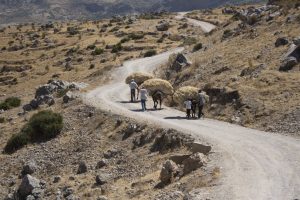After some reflection, the decision to undertake two simultaneous Zeppelin projects (Kashmir & Down By The Seaside) was an easy one. Each song presents unique challenges, and both represent some of the best of what Led Zeppelin was and could be. Tackling both simultaneously will be our attempt to up our game and our output (no more waiting 18 months between project releases). This site needs more content and these songs will definitely inspire lots of good discussion and articles for publication. Kashmir as a song is not to be taken lightly and the prospect and danger of releasing yet another poorly executued or uninspired cover on the world made me hesitate to choose it. It’s a relatively simple song in terms of the guitar arrangement, but like any Stairway cover, the signal to noise ratio of other covers of the song will make it harder to find an audience. But that there will be the challenge; to pull off a fantastic N4N cover of Kashmir that’s exciting and compelling and touches on the essence of what makes it such a great song. We’re hoping to achieve that – and a little more.

DADGAD
Kashmir was born of Jimmy Page’s love for alternate guitar tunings – specifically a tuning called DADGAD. (There are 4 songs in the Zeppelin catalogue that feature this tuning: Black Mountainside, White Summer, Kashmir, & Swan Song.) DADGAD can be considered a Celtic tuning and encourages the use of drone strings (the repeated “D’s”) often found in Celtic folk music. Although drone strings are a common element in Eastern Music, their roots in the Western tradition can be traced back to the earliest form of plainchants with the repetition of single notes as a musical idiom that eventually evolved into the beginnings of Western harmony as polyphony was born. In this way Kashmir is as much Celtic as is it Indian or North African (Eastern). The East/West duality of the DADGAD tuning has been explored by other musicians as well – most notably in Michael Hedges‘ composition Ragamuffin, but George Harrison was also known to use it (see Norwegian Wood). Ironically it also became a popular Appalachian tuning – music not usually associated with Eastern sounds – but such is the universality of music (and the decidedly Celtic Anglo-Scot roots of the territory).
The musical parts that eventually comprised Kashmir were part of a tuning cycle that Jimmy used when playing & tuning his DADGAD tuned guitars. For non guitar players, or those unfamiliar with alternate tunings, it can take some time to get a guitar in tune with itself so it’s common to develop little musical pieces that explore the relationship of different strings played in concert with each other in several different positions on the guitar as part of the tuning process itself. Kashmir’s guitar parts have some very specific hallmarks that speak to this origin.
…The Road to Morocco
For Robert Plant, Kashmir began as a lyrical fragment he called “Driving to Kashmir” that he penned on a North African road during a trip to Morocco. For certain, Kashmir (a region of India) is far removed from North Africa’s Morocco, but as Robert will attest, Kashmir the song is not so much about a place as it is an idea in the mind. Kashmir is a product of the imagination in the Orientalist tradition as understood by Edward Said in his book Orientalism (something we will explore in future articles) and many of the tropes and images the lyrics evoke are rooted in this history. One can only imagine a young Robert Plant exploring the vistas of the world and experiencing the otherness of distant lands and cultures – Kashmir is a product of this traveller’s journey.
Destination Kashmir
The exact moment that Jimmy’s guitar tuning inspired musical sketch met Robert’s lyrical fragment is not fully articulated in Zeppelin lore – but the end product – the song Kashmir itself – is definitely a case where the whole is greater than the sum of its parts as Kashmir is considered by some (including the band) to be the best song in the whole Led Zeppelin catalogue. It’s a tall order and a big project to take on – but we’ll do our best to deliver as we go forward with our cover. Keep checking back and track the project progress as we travel our own road to Kashmir. We’ll get there too! We promise.
Photo Credits:
Feature Image: P1020132b by hedgewytch via Flickr (CC BY-NC 2.0)
Morocco by Sam Greenhalgh via Flickr (CC By 2.0)
